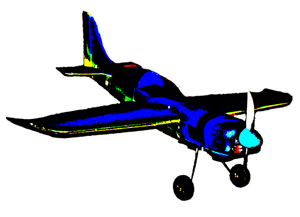3D printing in model aircraft construction

Not so long ago, it seemed unthinkable to 3D print a complete (and usable) RC model aircraft. The first
models flew more or less well, and were heavy and fragile.
With modern filaments, it is now possible to produce light and yet robust models with almost any 3D
printer.
Producing 3d printed RC model aircrafts is nevertheless a special challenge. They have to be light and stable and should fly well. But it's possible! Even models that are suitable for beginners.
I only use open source software on my Linux-based PC for the construction and preparation of the print files. This allows amazing results to be achieved with high precision. However, sometimes you have to think outside the box a little to get the right result.

My models are designed for a "standard printer" with an printing space of 200x200x200mm. So you don't
need an extra large printer, even if the model ends up having a wingspan of well over 1000mm.
The 3d printed individual parts are glued together with superglue or epoxy resin.
The stability of my models does not result from the printed parts, but from carbon or fiberglass rods
that hold the parts together and align them when glued together.
Disadvantages of 3d printed RC model airplanes
-
3D printed RC flight models are less stable than models made from EPP or XPS. Therefore, I think they are not always suitable for beginners.
You should be able to take off and land a flight model safely, otherwise you won't have much fun with your 3D-printed plane. -
Models printed from standard PLA or PETG are not really lightweight. The additional weight has to be compensated by a higher ground speed. They also have to be landed faster than similarly sized models made of XPS foam or balsa wood.
-
The overall printing time of a flight model is often 100 hours and sometimes much more. So you have to be patient until you have printed all the parts needed for assembly.
-
For models with a wingspan of more than 1.50m, you often need more than one roll of filament. Nevertheless, the printing costs can often be lower than a kit or ready to fly model of the same size.
-
A disadvantage of PLA, which you should definitely take into account, is the low temperature stability of the material. This is around 50°C. Above that, the model begins to soften.
Leaving a PLA model lying on the airfield in the blazing sun at midday in summer is not a good idea!
If you leave your PLA model in the hot trunk of your car in midsummer, which you have just parked in the blazing sun, you will have an indefinable lump of plastic after a relatively short time!
But since I don't fly in the heat of summer anyway, that's not a problem for me.
Advantages of 3d printed RC model airplanes
-
Minor repairs resulting from rough landings can often be done with a few drops of superglue.
-
Defective or destroyed parts can easily be reprinted.
-
Even if the pure printing time is long, assembling a 3d printed model takes only a few hours with a little skill and experience. If the parts are well thought out in terms of construction and fit precisely, the assembly is also easy for less experienced model builders.
-
With new, foaming filaments, very light models can be printed, whose flight characteristics come close to those of "foam waffles".
-
The "coolness factor" of a 3d printed model is still high.
